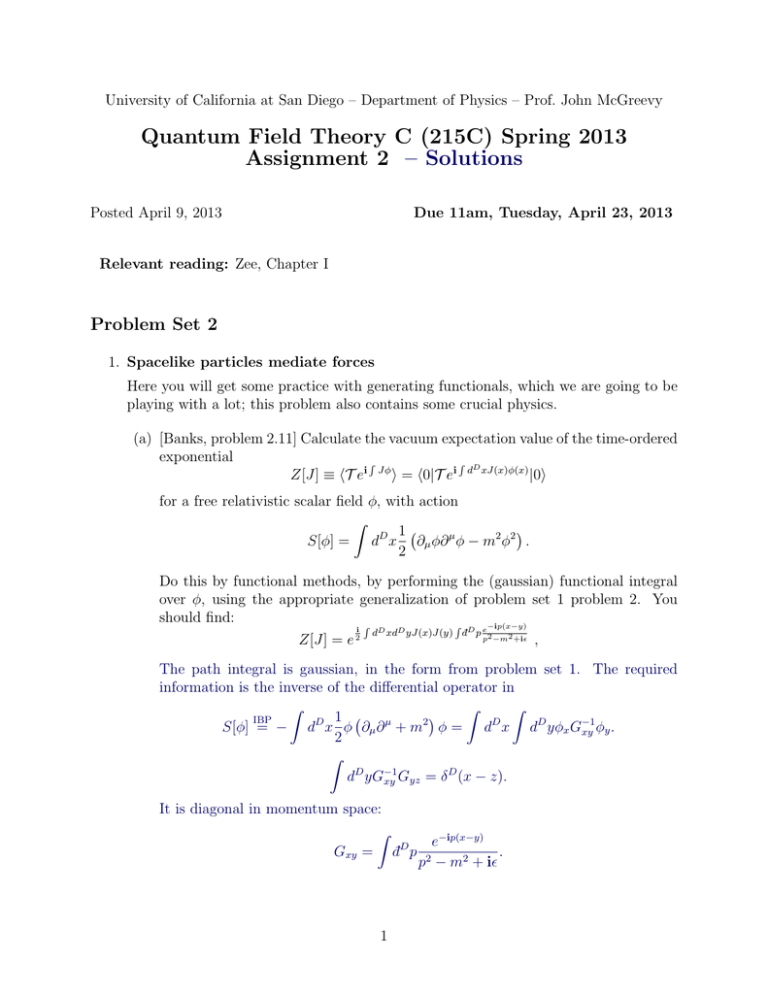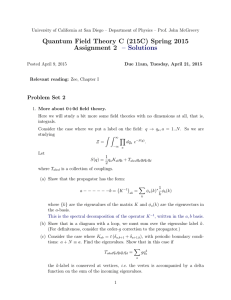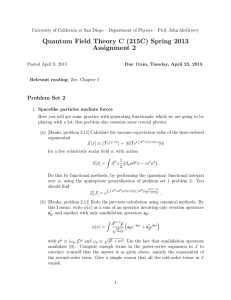Quantum Field Theory C (215C) Spring 2013 Assignment 2 – Solutions
advertisement

University of California at San Diego – Department of Physics – Prof. John McGreevy
Quantum Field Theory C (215C) Spring 2013
Assignment 2 – Solutions
Posted April 9, 2013
Due 11am, Tuesday, April 23, 2013
Relevant reading: Zee, Chapter I
Problem Set 2
1. Spacelike particles mediate forces
Here you will get some practice with generating functionals, which we are going to be
playing with a lot; this problem also contains some crucial physics.
(a) [Banks, problem 2.11] Calculate the vacuum expectation value of the time-ordered
exponential
R
R D
Z[J] ≡ hT ei Jφ i = h0|T ei d xJ(x)φ(x) |0i
for a free relativistic scalar field φ, with action
Z
1
S[φ] = dD x ∂µ φ∂ µ φ − m2 φ2 .
2
Do this by functional methods, by performing the (gaussian) functional integral
over φ, using the appropriate generalization of problem set 1 problem 2. You
should find:
R D D
R
−ip(x−y)
i
d xd yJ(x)J(y) d¯D p e 2
p −m2 +i ,
Z[J] = e 2
The path integral is gaussian, in the form from problem set 1. The required
information is the inverse of the differential operator in
Z
Z
Z
IBP
D 1
µ
2
D
S[φ] = − d x φ ∂µ ∂ + m φ = d x dD yφx G−1
xy φy .
2
Z
D
dD yG−1
xy Gyz = δ (x − z).
It is diagonal in momentum space:
Z
e−ip(x−y)
Gxy = d¯D p 2
.
p − m2 + i
1
(b) [Banks, problem 2.11] Redo the previous calculation using canonical methods. By
this I mean: write φ(x) as a sum of an operator involving only creation operators
ap†~ , and another with only annihilation operators ap~ :
Z D−1 d¯ p~
† ipx
−ipx
p
ap~ e
+ ap~ e
φ(x) =
2ωp~
p
with pµ ≡ (ωp , p~)µ and ωp ≡ p~2 + m2 . Use the fact that annihilation operators
annihilate |0i. Compute enough terms in the power-series expansion in J to
convince yourself that the answer is as given above, namely the exponential of
the second-order term. Give a simple reason that all the odd-order terms in J
vanish.
Z0 [J] = hT e
i
R
Jφ
i
∞ Z
X
=
n=0
odd terms are zero
=
=
dxn ..dx1 Jn ...J1 hT φn ...φ1 i
∞
X
m≡n/2=0
i2m
(2m)!
in
n!
Z
dx2m ...dx1 J2m ...J1 hT φ2m ...φ1 i .
|
{z
} |
{z
}
P
symmetric under perms =
(m contractions)
Here I’ve denoted φn ≡ φ(xn ). The odd order terms vanish because we need an a
for every a† to get a nonzero answer. Each contraction is
Z
e−ip(x−y)
,
hT φ(x)φ(y)i = iG(x − y) = i d¯D p 2
p − m2 + i
the Feynman Green’s function as above. The 2m-point function for the free theory
is the sum over ways of contracting pairs of φs using the two-point function. How
many ways are there to make m contractions of 2m objects? I claim the answer is
(2m)!
. The 2m is from the fact that the contractions are unordered pairs. The m!
2m m!
comes from the fact that the results of the m contractions commute. Therefore:
2m Z
X i2m (2m)! Y
iG
iG
dxi J J
Z0 [J] =
···
J J
(2m)! 2m m! i
2
2
12
34
m
!m
X i2m Z
iG
dxdy J J
=
m!
2
xy
m
i
= e− 2
R
dx
R
dyJGJ
,
as above.
(c) Now consider the particular choice of source
JR (x) = θ(T − t)θ(t + T ) q1 δ D−1 (x) + q2 δ D−1 (x − R)
~ µ is a constant vector and T R 1/m. This corresponds
where Rµ = (0, R)
to two static, localized source particles interacting for a time duration T , at a
~ Show that in the regime indicated, the answer has the form
separation R.
Z[JR ] ∝ e−iT V (R)
2
−mR
where for D = 3+1, V (R) ∼ q1 q2 e R is the Yukawa potential. (We are interested
in the dependence on R, and therefore can ignore factors in Z that don’t depend
on R.)
Interpret V as the potential energy of interaction between the two external particles. To obtain the force between the sources mediated by φ, differentiate the
potential with respect to the displacement: F = −∂R V . Is the force attractive or
repulsive when q1,2 have the same sign?
For time-independent sources, the vacuum persistence amplitude in the presence
of the source (Z0 [J]) determines the energy of the groundstate in the presence of
the source:
R
Z0 [J] = hT e Jφ i = h0J |e−iHJ T |0J i = e−iEJ T .
This relation is best summarized by
W [J] = −EJ T
for static sources J(~x) (this is actually an important sign!) We interpret this energy EJ = V (R) as the potential energy required to place the particles a distance
R apart. According to the previous parts of the problem, this is
Z Z
RR
1
JGJ
iW
− 2i
or W =
JGJ
Z=e =e
2
so
Z Z
1
−T V (R) =
JGJ
2Z
Z
1
eip(x−y)
D
D
D−1
=
dp
¯ 2
d xd y2q1 q2 θ(T − x0 )θ(x0 + T )δ
(~x)
θ(T − y0 )θ(y0
2
p + m2 + i
Z T
Z T
Z
Z
~
ei~p·R
iω(x0 −y0 )
dx0
dy0 dωe
=
¯
d¯D−1 p~
−ω 2 + p~2 + m2 + i
−T
−T
One combination of the time integrals enforces energy conservation (T 1) and
gives
~
ei~p·R
D−1
dω2πδ(ω)q
¯
q
d
¯
p
~
1 2
−ω 2 + p~2 + m2 + i
Z
~
ei~p·R
= T q1 q2 d¯D−1 p~ 2
p~ + m2 + i
Z
Z
−T V (R) = T
(2)
In the limit m 1/R we can do the integal by scaling (change variables to
p̃ ≡ pR) and find
m→0
1
V (R) ≈
;
D−3
R
Actually this follows by dimensional analysis. It is wrong for D = 2 + 1 where we
find a logarithm – the potential actually grows with distance in D ≤ 2 + 1.
3
Now consider nonzero m. For the special case of D = 3 + 1 choose the polar axis
~ so u = cos θ = p̂ · R̂ and
for p~ along R,
Z
I≡
~
D−1
d¯
ei~p·R
1
p~ 2
=
2
p~ + m + i
(2π)3
Z
2π
∞
Z
dϕ
0
0
1
eikRu
2i
k dk
du 2
=
2
k +m
(2π)2 iR
−1
2
Z
Z
dkk
0
The integrand is even in k so it’s the same as
Z
Z
sin kR
eikR
11 ∞
1 1 ∞
dkk 2
dkk
I=
=
R 2 −∞
k + m2
R 2i −∞
k 2 + m2
and now we can do it by residues. The contour at infinity in the UHP gives zero,
and the residue of the pole in the UHP gives
VD=3+1 (R) = −
q1 q2 −mR
e
.
4πR
For general dimensions and general m, we can use scaling to write the integral as
VD (R) =
1
RD−3
where the dimensionless function is
Z
f (mR) = d¯D−1 p̃
f (mR)
eip̃·R̂
;
p̃2 + (mR)2 + i
notice that this does not depend on the direction R̂. We showed above that the
limit of small argument (m 1/R) is f (mR → 0) → a nonzero const. The limit
of large mass is a little trickier1 ; the same tricks as for D = 3 + 1 show that it goes
like (mR)D−2 e−mR . The important point is that it goes like e−mR – the range of
the potential is determined by the mass.
Unlike E&M, the force is attractive for like objects. For more on this calculation
see Zee §I.4
2. Schwinger-Dyson equations
Consider the path integral
Z
[Dφ]eiS[φ] .
Using the fact that the integration measure is independent of the choice of field variable,
we have
Z
δ
0 = [Dφ]
(anything)
δφ(x)
(as long as ‘anything’ doesn’t grow at large φ). So this equation says that we can
integrate by parts in the functional integral.
1
Thanks to Paul Rozdeba for finding an error in the problem statement on this point.
4
∞
sin kR
k 2 + m2
(Why is this true? As always when questions about functional calculus arise, you
should think of spacetime as discrete and hence the path integral
as simply
R measure
RQ
the product of integrals of the field value at each spacetime point, [Dφ] ≡
x dφ(x),
this is just the statement that
Z
∂
(anything)
0 = dφx
∂φx
with φx ≡ φ(x), i.e. that we can integrate by parts in an ordinary integral if there is
no boundary of the integration region.)
This trivial-seeming set of equations (we get to pick the ‘anything’) can be quite useful and are called Schwinger-Dyson equations. (Be warned that these equations are
sometimes also called Ward identities.) They provide a quantum implementation of
the equations of motion.
(a) Evaluate the RHS of
Z
0=
to conclude that
hT
[Dφ]
δ
φ(y)eiS[φ]
δφ(x)
δS
φ(y)i = −iδ(x − y).
δφ(x)
(3)
Use the product rule. The derivative hits either the φ(y) or the action.
(b) These Schwinger-Dyson equations are true in interacting field theories; to get some
practice with them we consider here a free theory. Evaluate (3) for the case of
a free massive scalar field to show that the (two-point) time-ordered correlation
functions of φ satisfy the equations of motion, most of the time. That is: the
equations of motion are satisfied away from other operator insertions:
hT +x + m2 φ(x)φ(y)i = −iδ(x − y),
(4)
µ
with x ≡ ∂xµ ∂ x .
With the stated assumptions, the EoM is
the previous result.
δS
δφ(x)
= (+x + m2 ) φ(x). Plug this into
(c) Find the generalization of (4) satisfied by (time-ordered) three-point functions of
the free field φ.
Choose the ‘anything’ to be φ(y)φ(z)eiS :
Z
δ
0 =
[Dφ]
φ(y)φ(z)eiS[φ]
δφ(x)
= hT x + m2 φ(x)φ(y)φ(z)i + iδ(x − y)hφ(z)i + iδ(x − z)hφ(y)i.
5
(d) Derive the equation (3) (for a free theory) from a more canonical (i.e. Hamiltonian) point of view, by considering what happens when you act with the wave
operator +x + m2 on the time-ordered two-point function.
[Hints: Use the canonical equal-time commutation relations:
[φ(~x), φ(~y )] = 0,
[∂x0 φ(~x), φ(~y )] = −iδ D−1 (~x − ~y ).
Do not neglect the fact that ∂t θ(t) = δ(t): the time derivatives act on the timeordering symbol!]
∂t2 h0|T φ(t, x)φ(t0 , x0 )|0i = ∂t (h0|T ∂t φ(t, x)φ(t0 , x0 )|0i + δ(t − t0 )h0|[φ(t, x), φ(t0 , x0 )]|0i)
Because of the δ(t − t0 ), the second term is proportional to the commutator of φs
at equal times, which we know and we know it’s zero. Doing it again we get:
∂t2 h0|T φ(t, x)φ(t0 , x0 )|0i = h0|T ∂t2 φ(t, x)φ(t0 , x0 )|0i+δ(t−t0 )h0|[∂t φ(t, x), φ(t0 , x0 )]|0i
The canonical equal-time commutator in the second term is now
[∂t φ(t, x), φ(t, x0 )] = −iδ D−1 (x − x0 )
(recall that ∂t φ =
∂L
∂ φ̇
is the field momentum). So
∂t2 h0|T φ(t, x)φ(t0 , x0 )|0i = h0|T ∂t2 φ(t, x)φ(t0 , x0 )|0i − iδ D (x − x0 ).
2
2
2
~
We may then use the Heisenberg equations of motion for ∂t φ(t, x) = ∇x + m φ(t, x)
on the RHS (e.g. in the free theory) to obtain:
2
2
2
~
∂t − ∇ − m h0|T φ(t, x)φ(t0 , x0 )|0i = +iδ D (x − x0 )
as above.
3. Making connected functions out of 1PI functions.
In this problem we prove the relations illustrated in Fig. 1. More precisely, we prove
that the φn term in the expansion of Γ[φ] is the 1PI n-point function.
(a) Show using the definitions of φc and the 1PI effective action that
−1
−1
δ2W
δφ(y)
δJ(x)
δ2Γ
=
=
=−
.
δJ(x)δJ(y)
δJ(x)
δφ(y)
δφ(x)δφ(y)
(5)
φ ≡ φc here). Inverse here means in the sense of integral operators:
R(where
dD zK(x, z)K −1 (z, y) = δ D (x − y). Convince yourself that (5) can be written
more compactly as:
W2 = −Γ−1
2 .
The expression (5) follows by differentiating the definition of φc :
and using the chain rule.
6
δW
δJ(x)
= φc (x)
Figure 1: [From Banks, Modern Quantum
Field Theory, with some improvement] Wn denotes
∂ n
the connected n-point function, ∂J W [J] = hφn i. Γn denotes the 1PI n-point function, as
encoded in the 1PI effective action.
(b) Show that
Z
W3 (x, y, z) =
Z
dw1
Z
dw2
dw3 W2 (x, w1 )W2 (y, w2 )W2 (z, w3 )Γ3 (w1 , w2 , w3 ) .
Do this by differentiating (5) again with respect to J and using the matrix
differentiation formula dK −1 = −K −1 dKK −1 and the chain rule.
W3 (x, y, z) ≡
δ3W
δΓ−1 (x, y)
=− 2
δJ(x)δJ(y)δJ(z)
δJ(z)
The indicated matrix derivative formula gives
Z
Z
δΓ2 (w1 , w2 )
W3 (x, y, z) = dw1 dw2 W2 (x, w1 )W2 (y, w2 )
.
δJ(z)
(6)
The last factor is going to be useful below; recall that Γ is naturally a function of
φ, so we need to use the chain rule:
Z
Z
δφ(w3 ) δΓ2 (w1 , w2 ) defs
δΓ2 (w1 , w2 ) chain rule
=
dw3
=
dw3 W2 (z, w3 )Γ3 (w1 , w2 , w3 ),
δJ(z)
δJ(z)
δφ(z)
which gives the stated expression when you plug it into (6).
(c) Show that Wn can be constructed from Γ and W2 as indicated in the figure. The
idea is to compute Wn by taking more derivatives with respect to J. To get the
rest of the Wn requires an induction step.
By now you see that differentiating Wn with respect to J the derivatives hit either
a W2 or a Γp , p ≤ n. If the former, it turns it into a W3 with the new external
7
R
leg sticking out. If the latter, it turns it into a W2 Γp+1 attached via W2 s as
previously, plus the new leg sticking out through the new W2 . These rules are
best understood in pictures:
But how do you make all the tree diagrams with n + 1 limbs? You stick extra
limbs on each feature of the sum of the tree diagrams with n limbs, just like this.
8


